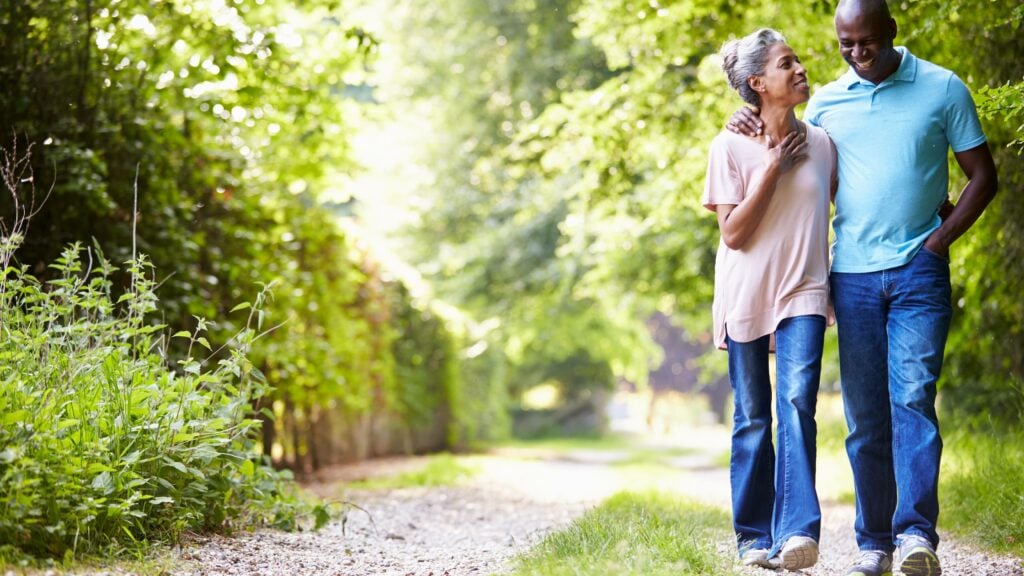
Fitness trackers: what you need to know
Jennifer Allen
We show you how to find the best walks near you
The saying ‘the best things in life are free’ could have been invented to describe walking. It’s the UK’s most popular form of exercise (Ramblers) there’s no need for specialist instruction or expensive kit, it’s on demand and you can do it from your doorstep.
Walking is the superhero of exercise, letting you explore stunning scenery, get fit and – if you go on to join a walking group – you might even find new love or a friend for life.
The saying ‘the best things in life are free’ could have been invented to describe walking. It’s the UK’s most popular form of exercise (Ramblers) there’s no need for specialist instruction or expensive kit, it’s on demand and you can do it from your doorstep.
Walking is the superhero of exercise, letting you explore stunning scenery, get fit and – if you go on to join a walking group – you might even find new love or a friend for life.
 Credit: Shutterstock / Monkey Business Images
Credit: Shutterstock / Monkey Business ImagesAs keen walkers, we’ve created the ultimate guide, with great advice from walk leaders, outdoors experts and, of course, our own experience, to help you get outside.
Just remember, all you need to do to start is to put one foot in front of the other.
Walking is the easiest form of exercise to start as it’s cheap and convenient, but it can also transform your health physically and mentally.
NHS Inform says that walking is proven to reduce the risk of some chronic illnesses, including heart disease, strokes, asthma, type 2 diabetes, obesity and some types of cancer through the myriad health improvements it brings.
The same research highlights how walking can also improve your mood and reduce your risk of depression.
If that’s not enough NHS Inform also says walking is amazing for older people, by increasing general mobility and body strength. It also helps maintain wellbeing and independence for those with long term conditions, meaning it offers a lot to a huge range of people.
 Credit: Sue Sharp
Credit: Sue SharpWalking really is popular in the UK. A 2022 study by the walking charity Living Streets found that 68 per cent of people in the UK walk for travel or leisure for at least 20 minutes every day. But that means 32 per cent of us still aren’t enjoying the benefits of this great exercise.
A 2020 report from the Centre for Ageing Better and the charity Sustrans found that barriers to walking for people aged 50-75 include bad weather, safety concerns and worries about fitness.
Walk leader Sue Sharp (pictured above), from Herefordshire, trained as a Hill and Moorland Leader after semi-retiring from a career in education. She said: “Lockdown changed a lot of attitudes towards walking. People realised you don’t need a dog or live in a rural area to go out for a walk.
“Since then, people have kept on walking because of the benefits to their physical and mental health and because they have found great places to walk.”
You don’t need another pandemic to start walking – you can beat the bad weather with a waterproof jacket which come in every size, colour and budget; if you are worried about walking alone, invite a friend to join you or sign up for a group walk. Or if it’s your fitness that’s holding you back, then start small with a five-minute walk and build it up from there.
 Credit: Phillipa Cherryson
Credit: Phillipa CherrysonYou’ve got your shoes on and you are ready to go, but before you head out the door, we’ve got some great practical tips from Glyn Dodwell (pictured below), who writes the award-winning Hill Walking for the over-60s blog:
 Credit: Glyn Dodwell
Credit: Glyn DodwellOnce you are happy walking short distances, then you can really start to have fun. In the UK we have stunning countryside, fascinating urban trails and beautiful coastlines – that’s the joy of starting walking, just being able to get out and explore them.
You don’t have to travel hours to find a great walk. There are great routes in towns and cities too, including parks, heritage trails, canal towpaths, riverside paths, commons, woodlands, heaths and nature reserves.
Yet for someone who’s never gone out exploring before, where do you start? How can you find these hidden gems and more importantly, how can you avoid getting lost?
We’ve pulled together tips from our own experience, our panel of outdoor enthusiasts and walk leaders:
 Credit: Phillipa Cherryson
Credit: Phillipa Cherryson Credit: Sue Sharp
Credit: Sue SharpAlthough many people enjoy the peace and tranquillity of walking alone, if you find a walking group, it can transform your walking, by teaching you new skills and increasing your confidence. It’s also a great way to stay motivated, meet new people and pep up your social life.
Loneliness can be an increasing problem as time passes too, with a 2018 study by Age UK finding that 1.4 million older people in the UK say they feel lonely and that figure is set to top two million within the next couple of years, but with hundreds of different walking groups across the country for all ages, interests and abilities it’s easy to find one to suit you.
Free beginners’ group walks across the UK include Walk for Health sessions organised by local councils, Wellbeing Walks organised by walking charity The Ramblers and in Scotland charity Paths For All organises free walks.
Social media is a great resource for finding walking or outdoor groups near you – or you could just Google ‘walking groups near me’ and the search engine will find the most relevant answers.
If you want the security of going on a walk by someone trained in the outdoors, then join a walk lead by a qualified guide.
Sharp adds: “For a beginner walker, joining a lead walk really makes a difference. You can learn new skills, explore places you’ve never been to before and gain more confidence.
“It’s a great way to meet other people but you don’t have to talk all the time, there are plenty of opportunities for quiet contemplation as you walk.
“I’ve had people become best friends or even fall in love on a group walk. It’s incredible that doing something as simple as going for a hike with other people can be so life changing.”
 Credit: Shutterstock / Zivica Kerkez
Credit: Shutterstock / Zivica KerkezJoining a walking group is a great way to stay motivated. But if you are walking solo how you can keep the walking habit going when it’s cold outside and you would rather stay in and watch telly?
Thankfully, there‘s loads you can do to help you not just stay motivated, but to help you develop a real passion for walking.
 Credit: Shutterstock/Monkey Business Images
Credit: Shutterstock/Monkey Business ImagesNow that you’ve been bitten by the walking bug you may want to start exploring more rural areas.
You might have your eye on climbing Yr Wyddfa (Snowdon), walking a section of the UK’s coastal path or visiting one of our national parks. Group walks or paying a walk leader to guide you is a great introduction to exploring these wilder and beautiful places.
But the real joy of walking is just getting outside , whatever distance you go. You might not have the desire or the health to go very far. For many, just being able to walk a mile or two is a justifiable cause for celebration.
Dodwell says: “Not everyone can climb a mountain or walk for miles. My wife suffers from fibromyalgia and is in a lot of pain. Her goal was to walk a mile.
“It took her more than a year to get that far but it was as big an achievement for her as it is for someone else to climb a mountain.
“For anyone thinking about having a go at walking, all that matters is that you are outside, putting one foot in front of another, breathing in the fresh air and enjoying feeling alive.”

Written by Phillipa Cherryson she/her
Published: Updated:
Phillipa Cherryson is a senior digital editor for Saga Exceptional. Phillipa has been a journalist for 30 years, writing for local and national newspapers, UK magazines and reporting onscreen for ITV. In her spare time she loves the outdoors and is a trainee mountain leader and Ordnance Survey Champion.